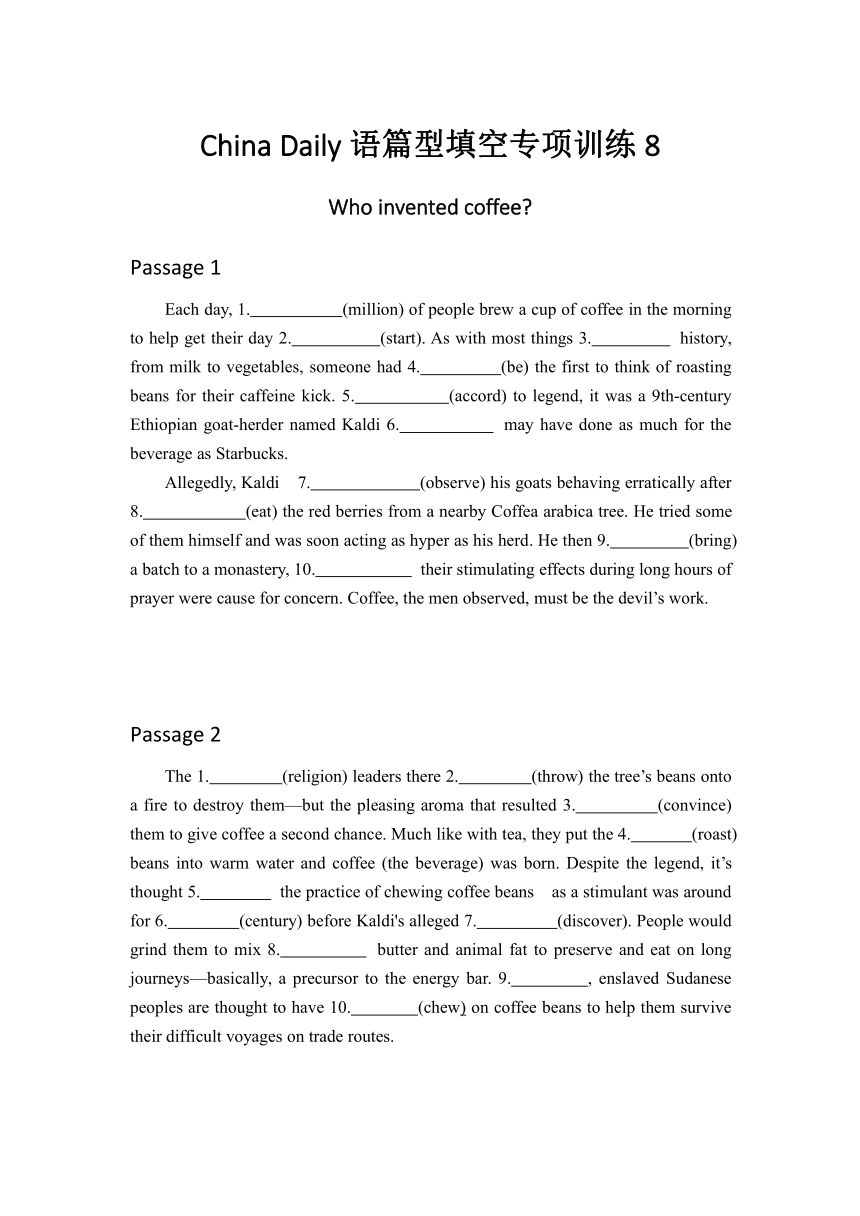
China Daily语篇型填空专项训练8 Who invented coffee Passage 1 Each day, 1. (million) of people brew a cup of coffee in the morning to help get their day 2. (start). As with most things 3. history, from milk to vegetables, someone had 4. (be) the first to think of roasting beans for their caffeine kick. 5. (accord) to legend, it was a 9th-century Ethiopian goat-herder named Kaldi 6. may have done as much for the beverage as Starbucks. Allegedly, Kaldi 7. (observe) his goats behaving erratically after 8. (eat) the red berries from a nearby Coffea arabica tree. He tried some of them himself and was soon acting as hyper as his herd. He then 9. (bring) a batch to a monastery, 10. their stimulating effects during long hours of prayer were cause for concern. Coffee, the men observed, must be the devil’s work. Passage 2 The 1. (religion) leaders there 2. (throw) the tree’s beans onto a fire to destroy them—but the pleasing aroma that resulted 3. (convince) them to give coffee a second chance. Much like with tea, they put the 4. (roast) beans into warm water and coffee (the beverage) was born. Despite the legend, it’s thought 5. the practice of chewing coffee beans as a stimulant was around for 6. (century) before Kaldi's alleged 7. (discover). People would grind them to mix 8. butter and animal fat to preserve and eat on long journeys—basically, a precursor to the energy bar. 9. , enslaved Sudanese peoples are thought to have 10. (chew) on coffee beans to help them survive their difficult voyages on trade routes. Passage 3 The story 1. Kaldi is difficult 2. (pin) down. 3. we do know is that true 4. (history) accounts of coffee consumption didn't materialize until much later, 5. devout Sufi in Yemen were said to use the drink 6. (remain) vigilant during religious rituals. The cultivation and trade of the beans 7. the drink began in Arabic countries in the 14th century and spread 8. Egypt, Syria, and Turkey. It’s said not a single coffee plant 9. (exist) outside of Arabia or Africa until the 1600s, when a pilgrim named Baba Budan 10. (bring) them back to India. Passage 4 1. 1616, Pieter van der Broeck smuggled some coffee out of Mocha, Yemen, and brought it back 2. Amsterdam. Soon, the Dutch and their colonies—most notably Sri Lanka and Java—3. (take) over the European trade, 4. (follow) by the French in the Caribbean, the Spanish in Central America, and the Portuguese in Brazil. The drink 5. (eventual) made its way to America via British colonizers 6. docked in New York City. Today, the average American 7. (spend) about $2000 a year 8. coffee. And 9. Kaldi may not be a household name like Folgers, he still gets his due. The St. Louis-based Kaldi’s Coffee takes its name from the most 10. (energy) goat herder in history. 参考答案 参考答案1 1.millions 2.started 3.in 4.to be 5.According 6.who 7.observed 8.eating 8.brought 10.where 参考译文1 每一天都有数百万人在清晨冲泡一杯咖啡来帮助自己开始新的一天。就像历史上大多数事物一样,从牛奶到蔬菜,总得有人第一 ... ...
~~ 您好,已阅读到文档的结尾了 ~~

